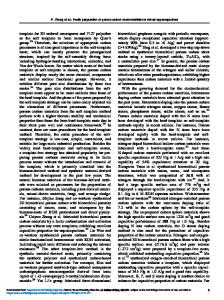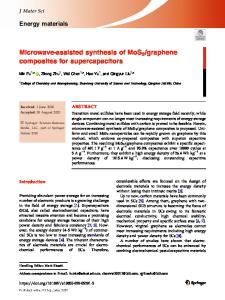Synthesis of nitrogen-doped porous carbon by solid grinding for supercapacitors
- PDF / 2,631,285 Bytes
- 8 Pages / 595.276 x 790.866 pts Page_size
- 65 Downloads / 409 Views
Synthesis of nitrogen-doped porous carbon by solid grinding for supercapacitors Juan Du1, Yifeng Yu1, Yue Zhang1, and Aibing Chen1,2,* 1
College of Chemical and Pharmaceutical Engineering, Hebei University of Science and Technology, 70 Yuhua Road, Shijiazhuang 050018, China 2 CAS Key Laboratory of Carbon Materials, Institute of Coal Chemistry, Chinese Academy of Sciences, Taiyuan, China
Received: 14 June 2020
ABSTRACT
Accepted: 12 October 2020
Nitrogen-doped porous carbon materials have been the outstanding candidates in supercapacitor applications due to their low cost, high surface area, abundant pore structure, suitable nitrogen doping content etc. Herein, nitrogen-doped porous carbon materials (NPC) were prepared via simple solid grinding using silica spheres as pore-forming agent and nitrogen-rich aniline as carbon/nitrogen precursor. The silica spheres create crossed macroporous structure that contributes to the transfer and storage of charge. NPC is continuously activated to give NPC-K, (where the K presents potassium hydroxide), further increasing its surface area and pore volume. The resulting NPC-K has hierarchical porous structures, high specific surface area, large pore volume, and suitable nitrogen doping. When used as an electrode material for supercapacitors, it has a good capacitance, rate performance, and cycle stability, demonstrating good electrochemical performance.
Ó
Springer Science+Business
Media, LLC, part of Springer Nature 2020
1 Introduction As one of the most promising candidate for energy storage devices, supercapacitors have triggered intense attention owing to the rapid charge–discharge, small size, long recycle, and environmental safety [1, 2]. Based on the two main charge storage mechanisms of electrical double-layer capacitors (EDLC) that store energy by charge accumulation and redox capacitors in which the pseudocapacitance arises due to the faradic reactions, the carbon materials and many porous metal oxides or conductingpolymers-derived electrodes have been widely used
Address correspondence to E-mail: [email protected]
https://doi.org/10.1007/s10854-020-04661-4
[3, 4]. It is a well-known fact that the capacitive behavior of supercapacitors depends intimately on their electrode materials. The properties of electrode materials including surface area, pore size, and pore volume absolutely determine the energy storage ability of supercapacitors based on EDLC mechanism, in which the carbon materials were the most widely studied [5]. The rich pores for carbon framework can help to improve the electrochemical properties of the carbonaceous material. The porous carbon materials with meso, micro, and macroporous structure can be used as ideal electrodes for improving the
J Mater Sci: Mater Electron
performance of supercapacitors [6, 7]. Macroporous structures can work as a quick buffering reservoir, while the mesopores and micropores endow the electrode with a high accessible surface area to ensure the ion transport and charge accommodation [8, 9]. Up to now, template and a
Data Loading...











